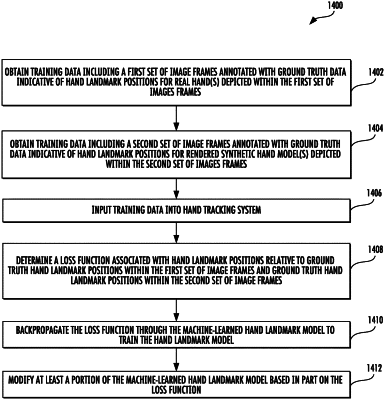| CPC G06T 7/251 (2017.01) [G06T 7/75 (2017.01); G06V 40/28 (2022.01); G06T 2207/20081 (2013.01); G06T 2207/30196 (2013.01)] | 19 Claims |

|
1. A computing system for hand tracking, the system comprising:
one or more processors; and
one or more non-transitory computer-readable media that collectively store instructions that, when executed by the one or more processors, cause the one or more processors to perform operations, the operations comprising:
obtaining a first image frame, wherein the first image frame is descriptive of a hand comprising a palm;
processing the first image frame with a machine-learned palm detection model to generate one or more bounding boxes associated with a position of the palm, wherein the position of the palm is determined with the machine-learned palm detection model based on one or more features in the first image frame;
processing the one or more bounding boxes with a machine-learned hand landmark model to determine a first plurality of hand landmark positions within the first image frame based at least in part on the one or more bounding boxes;
obtaining ground truth data associated with ground truth hand landmark positions;
determining a loss function associated with the first plurality of hand landmark positions relative to the ground truth data; and
backpropagating the loss function associated with the first plurality of hand landmark positions to the machine-learned palm detection model to train the machine-learned palm detection model.
|